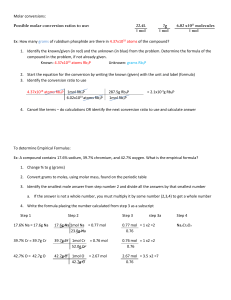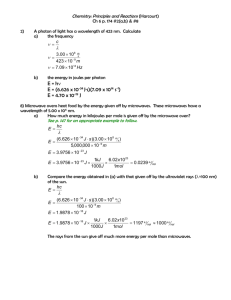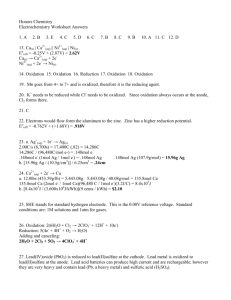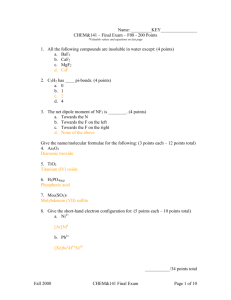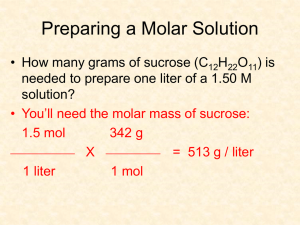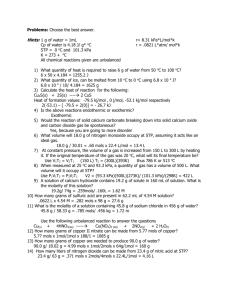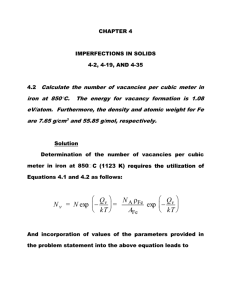KEY
advertisement
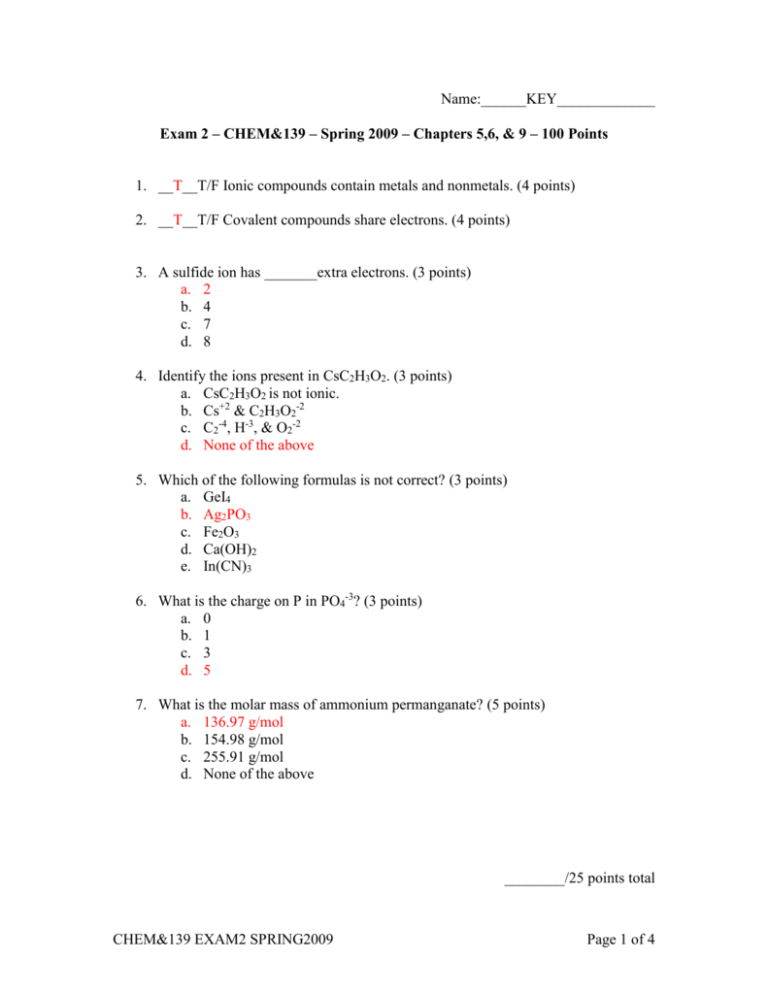
Name:______KEY_____________ Exam 2 – CHEM&139 – Spring 2009 – Chapters 5,6, & 9 – 100 Points 1. __T__T/F Ionic compounds contain metals and nonmetals. (4 points) 2. __T__T/F Covalent compounds share electrons. (4 points) 3. A sulfide ion has _______extra electrons. (3 points) a. 2 b. 4 c. 7 d. 8 4. Identify the ions present in CsC2H3O2. (3 points) a. CsC2H3O2 is not ionic. b. Cs+2 & C2H3O2-2 c. C2-4, H-3, & O2-2 d. None of the above 5. Which of the following formulas is not correct? (3 points) a. GeI4 b. Ag2PO3 c. Fe2O3 d. Ca(OH)2 e. In(CN)3 6. What is the charge on P in PO4-3? (3 points) a. 0 b. 1 c. 3 d. 5 7. What is the molar mass of ammonium permanganate? (5 points) a. 136.97 g/mol b. 154.98 g/mol c. 255.91 g/mol d. None of the above ________/25 points total CHEM&139 EXAM2 SPRING2009 Page 1 of 4 8. How many grams are in 2.09 mol hydrogen gas? (5 points) 2.09mol 2.0159 g 4.21g 1mol 9. What is the mass percent of nitrogen in cobalt (III) nitrite? (5 points) Co( NO2 )3 42.0201 100 21.3354% 196.950 10. A 0.77 mg sample of nitrogen reacts with chlorine to form 6.61 mg of the chloride. What is the empirical formula of the nitrogen chloride? (8 points) 1g 1mol 5.5 105 molN 1000mg 14.0067 g 1g 1mol 5.84mg 1.6 104 molCl 1000mg 35.4527 g 0.77 mg 5.5 105 mol 5.5 105 mol 1.0 N 1.6 104 mol 5.5 105 mol 3.0Cl NCl3 11. Name the following compounds/state their chemical formulae: (2 points each – 24 points total) a. Silver perchlorate AgClO4 b. Molybdenum (II) arsenide c. P2O5 diphosphorous pentoxide d. Boron trihydride e. BaCO3 Mo3As2 BH3 barium carbonate ________/28 points total CHEM&139 EXAM2 SPRING2009 Page 2 of 4 f. NiCl2 nickel (II) chloride g. Phosphorous acid H3PO3(aq) h. HCN(aq) hydrocyanic acid i. Bi(MnO4)5 bismuth (V) permanganate j. TiO2 titanium (IV) oxide k. SiO2 silicon dioxide l. Sulfur trioxide SO3 12. Give the short-hand electron configurations for the following species: (3 points each – 15 points total) a. Al [Ne]3s23p1 b. Br[Kr] c. Y3+ [Kr] d. Ag [Kr]5s14d10 e. Cr [Ar]4s13d5 13. Balance the following equations: (4 points each – 8 points total) a. _1__Fe2O3(s) + __3_H2SO4(aq) __1_Fe2(SO4)3(aq) + _3_H2O(l) b. _2__C20H42(g) + _61__O2(g) __40_CO2(g) + _42_H2O(l) ________/37 points total CHEM&139 EXAM2 SPRING2009 Page 3 of 4 14. Calculate the empirical and molecular formulae of acetaminophen (Tylenol), given: C, 63.56%; H, 6.00%; N, 9.27%; O, 21.17% and a molecular mass of 151.169 g/mol. (10 points) 1mol 5.292mol 0.662mol 7.990 8C 12.011g 1mol 6.00 gH 5.95mol 0.662mol 8.99 9 H 1.00794 g 1mol 9.27 gN 0.662mol 0.662mol 1.00 1N 14.0067 g 1mol 21.17 gO 1.323mol 0.662mol 1.998 2O 15.9994 g emp for C8 H 9 NO2 151.165 g / mol 63.56 gC 151.169 g / mol 1 151.165 g / mol molecular formula (C8 H 9 NO2 )1 C8 H 9 NO2 n ________/10 points total CHEM&139 EXAM2 SPRING2009 Page 4 of 4
